Summary: Throughout 2013, 2014 and early 2015, fund managers were heavily overweight equities and underweight cash and bonds. Those allocations have entirely flipped in 2016, with investors persistently shunning equities in exchange for holding cash.
Global equities are more than 15% higher than in February. A tailwind for this rally has been the bearish positioning of investors, with fund managers' cash in October rising to the highest level since 2001. Similarly, their equity allocations are now like those in February, mid-2010 and mid-2012, periods which were notable lows for equity prices during this bull market. Overall, fund managers' defensive positioning supports higher equity prices in the month(s) ahead.
Allocations to US equities had been near 8-year lows over the past year and half, during which the US outperformed most of the world. After rising for two months during the summer, allocations fell again to underweight in both September and October. Bearish sentiment remains a tailwind for US equities.
European equity markets, which had been the consensus overweight and also the world's worst performing region, are now underweighted relative to their long term mean. Investors are chasing the world's best performing region - emerging markets - which now have their highest overweight in 3 1/2 years. Emerging markets may rise further but note that the contrarian long trade is now over.
Among the various ways of measuring investor sentiment, the BAML survey of global fund managers is one of the better as the results reflect how managers are allocated in various asset classes. These managers oversee a combined $600b in assets.
The data should be viewed mostly from a contrarian perspective; that is, when equities fall in price, allocations to cash go higher and allocations to equities go lower as investors become bearish, setting up a buy signal. When prices rise, the opposite occurs, setting up a sell signal. We did a recap of this pattern in December 2014 (post).
Let's review the highlights from the past month.
Cash: Fund managers' cash levels at the equity low in February were 5.6%. Despite the rise in global equities since then, cash levels are now higher, at 5.8%. This is equal to the high after the Brexit vote in July, higher than at any time during the 2008-09 bear market and at the highest since November 2001. Even November 2001, which wasn't a bear market low, saw equities rise nearly 10% in the following 2 months. High cash levels are supportive of further gains in equities in the month(s) ahead. Enlarge any image by clicking on it.
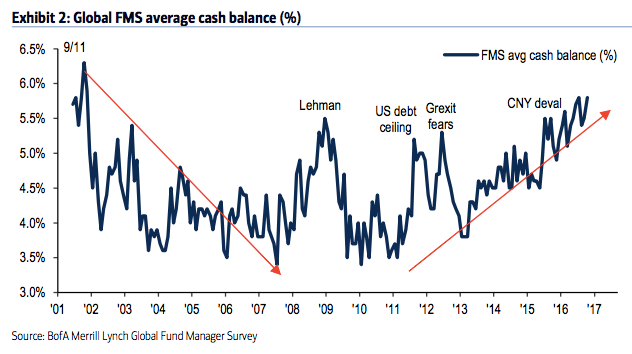
Global equities: Fund managers were just +5% overweight equities at their low in February; since 2009, allocations had only been lower in mid-2011 and mid-2012, periods which were notable bottoms for equity prices during this bull market. Allocations in October are only marginally higher, at +11% overweight. This is 0.7 standard deviations below the long term mean and supportive of further gains in equities in the month(s) ahead.

Relative to bonds, commodities and cash, allocations to equities remain near the lows formed in mid-2010, 2011 and 2012. This is supportive of further gains in equities.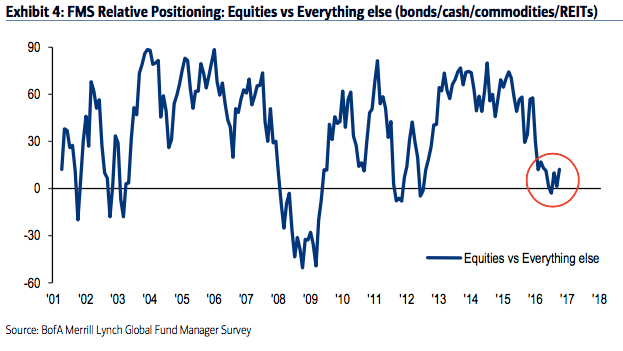
In February, 16% of fund managers expected a weaker economy in the next 12 months, the lowest since December 2011. Investors are still pessimistic, with only 19% expecting a stronger economy in the next year. This explains the low allocations to equities and high allocations to cash.
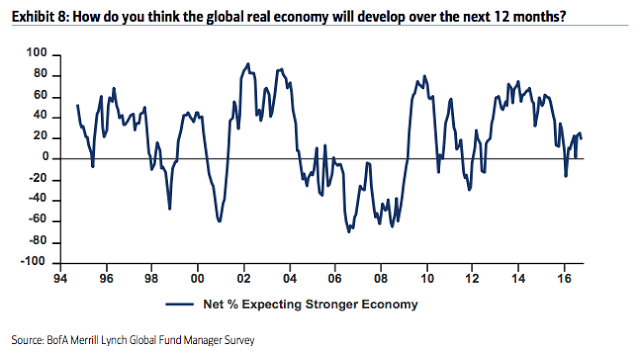
US equities: US exposure had been near an 8 year low during the past year and a half, during which US equities outperformed. US equities have been under-owned. After rising for two months this summer, allocations fell again to -7% underweight in both September and October. Bearish sentiment remains a tailwind for US equities.
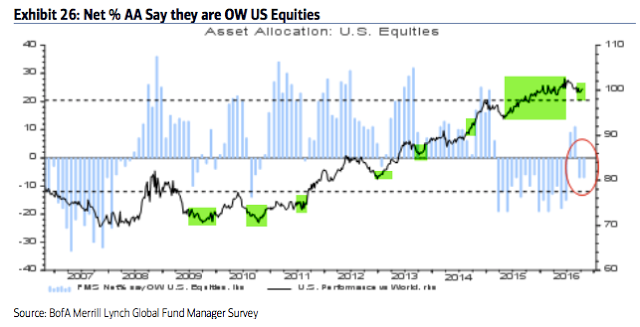
European equities: Fund managers had been excessively overweight European equities for more than a year, during which time EZ equities underperformed. That changed in July, with the region becoming underweighted for the first time in 3 years. That improved slightly to +5% overweight in both September and October. This is 0.4 standard deviations below its long term mean. EZ equities have outperformed in the past 4 months since becoming underweighted.
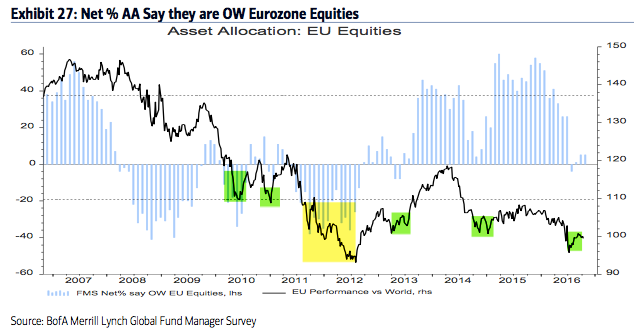
Japanese equities: Allocations to Japan have been falling in 2016 as the region has underperformed. Allocations fell to -8% underweight in September, the lowest since December 2012, before rising slightly in October to -3% underweight (0.3 standard deviations below its long term mean).

Emerging markets equities: The contrarian long in emerging markets is over. A brief recap: in January, allocations to emerging markets fell to their second lowest in the survey's history (-33% underweight), an extreme comparable only to early-2014 from which the region began to strongly outperform for the next half a year. Allocations have since risen to +31% overweight, the highest in 3.5 years. This is now 0.5 standard deviations above its long term mean. The region has outperformed the rest of the world so far 2016. There is room for exposure to increase further but allocations are now above where several prior rallies have either stalled or failed (arrows).
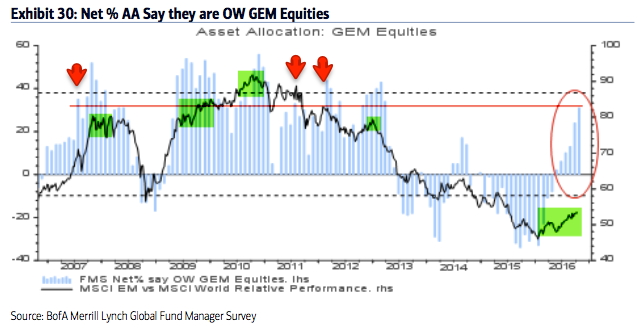
Global bonds: Fund managers are -50% underweight bonds, a fall from -35% in July (which was near a 3.5 year high allocation). This is neutral relative to the long term mean. Bonds outperformed in the 10 months before the current equity rally began in February, as allocations increased from -64% underweight in December (a 2-year low; green shading). Note that bonds have historically started to underperform when allocations rise to -20% underweight (red shading).
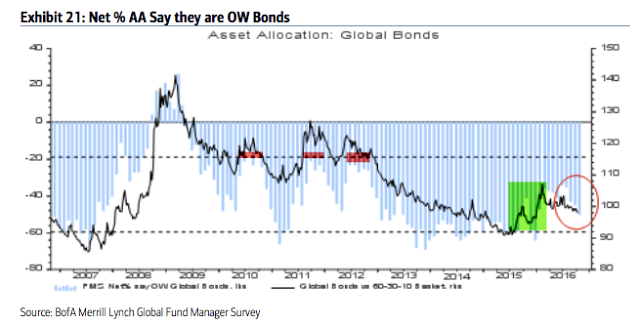
Bond allocation relative to cash are now at the lowest level since July 2006, as fund managers prefer liquidity over low yield. It's only one data point, but July 2006 was a turning point for US Treasuries, from which price rose and yields fell (arrow in second chart).


Commodities: Allocations to commodities rose to a 4 year high at 0% over/underweight. This is neutral relative to the long term mean. In comparison, in February, allocations were near one of the lowest levels in the survey's history (-29% underweight). The improvement in commodity allocations goes together with that for emerging market equities.
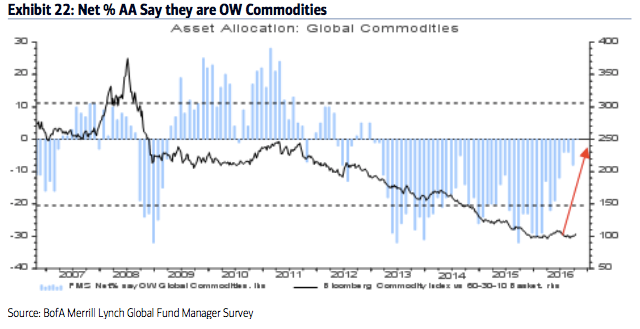
Sectors: Relative to history, managers are extremely overweight cash. They are more weighted towards bonds than equities. Overall, this is very defensive positioning.
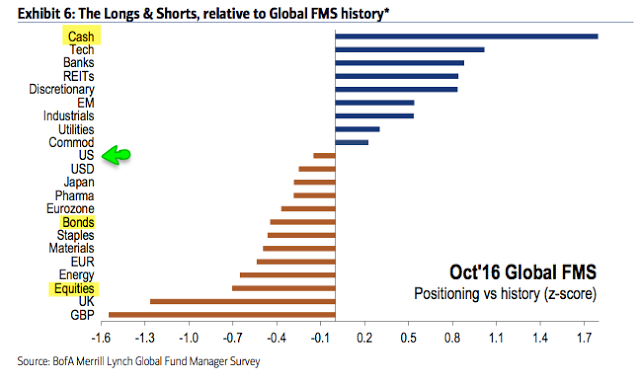
Fund managers' risk appetite is 1.1 standard deviations below the mean; during the current bull market, risk appetite has only been materially lower in mid-2011 and 2012, relative lows from which equities rose strongly in the following months. Risk appetite is the average of fund managers cash, investment horizon and investment risk (e.g., equity allocation and sector weighting).
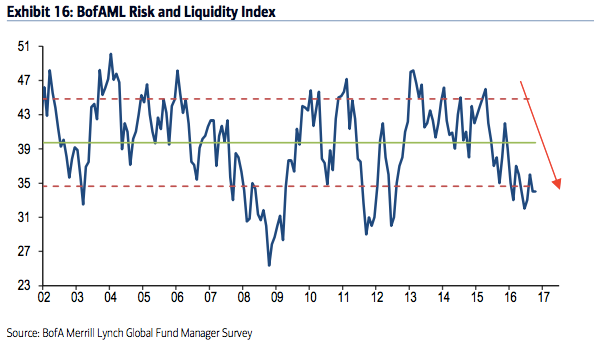
Survey parameters are below.
- Cash: Typical range is 3.5-5%. BAML has a 4.5% contrarian buy level but we consider over 5% to be a better signal. More on this indicator here.
- Equities: Over +50% is bearish. A washout low (bullish) is under +15%. More on this indicator here.
- Bonds: Global bonds started to underperform in mid-2010, 2011 and 2012 when they reached -20% underweight.
- Commodities: Higher commodity exposure goes in hand with improved sentiment towards EM.
